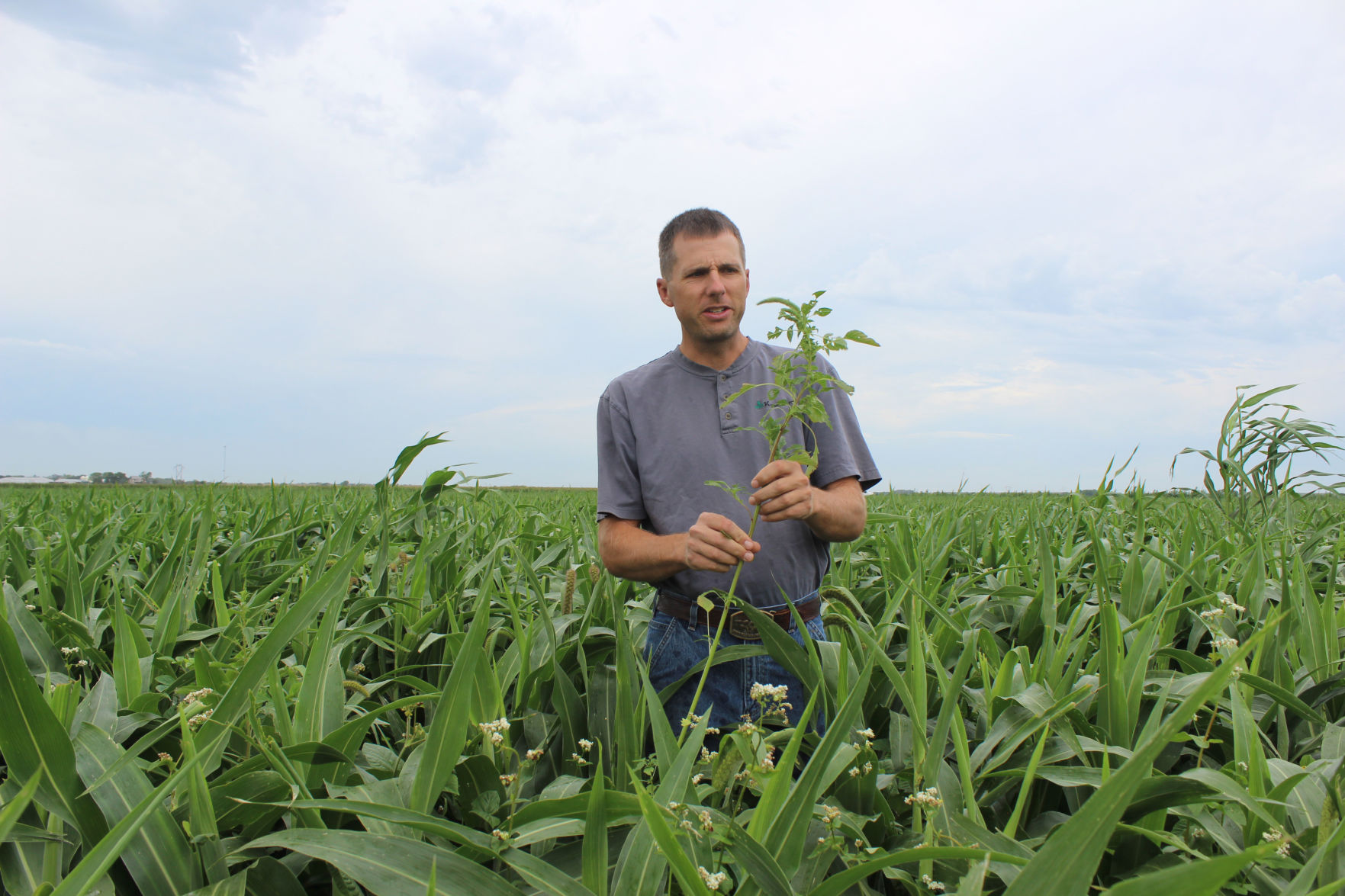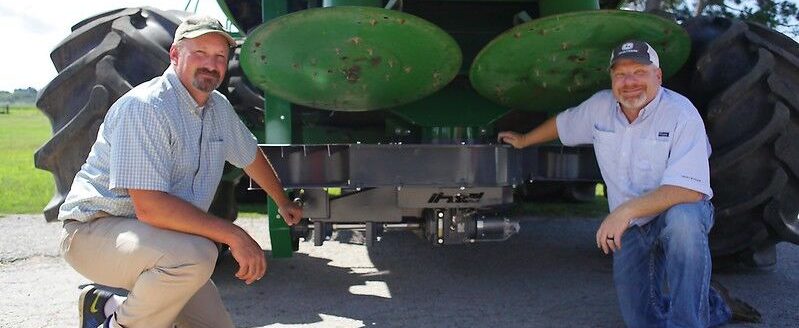Farmers wage war on weeds and pests through intercropping

No-till on the Plains study features intercropping of sorghum at 4 sites across Kansas
On an early August morning, Justin Knopf points out a patch of pigweed growing above his canopy of grain sorghum.
It’s the scourge of any crop field—growing in resistance to even some of the most aggressive chemical treatments. Yet, on this outing, the Gypsum, Kansas, farmer looks at the invasive weed with a glass-half-full mentality.
“Honestly, the field is better than I thought it would be with no herbicide,” he said.
Knopf wasn’t sure of the outcome when No-till on the Plains Director Steve Swaffer asked him to participate in an intercropping study this summer with three other farmers from across Kansas. The concept went against his normal routine of combatting pigweed, known as palmer amaranth. Knopf was told once he planted the acreage, he couldn’t apply herbicides or pesticides, instead relying on Mother Nature’s biological warfare.
The weapons? Buckwheat, guar, flax, mung bean and clover, to name a few of the greens growing in between Knopf’s sorghum rows.
The goal is to see how well cover crops choke out unwanted weeds and attract beneficial insects like lacewings and lady beetles, which feed on pests like sugarcane aphids, Swaffer said. The hope is farmers can save dollars per acre by not having to spray while building their soil health.
A Sustainable Agriculture Research and Education program grant through the U.S. Department of Agriculture helped fund the study, he said. The grant paid for some of the sorghum seed, intercropping seed and custom farming rates.
“You might not have to spray for aphids two or three times, or maybe not even once,” Swaffer said, adding the study allowed farmers to explore something they might not normally have tried otherwise.
“The thing about these four guys, they wanted to try to learn from it,” he said. “The SARE grant gave them the opportunity to do so without risk.”
Rebuilding his soils
For Knopf, regenerative agriculture isn’t a new concept on his farm.
However, getting to where he is today hasn’t been easy. Four generations of his family have farmed the land in central Kansas, growing crops and tilling the soil. And, Knopf, the fifth generation, doesn’t claim to have the answers. But he knew one thing when he came back from college. He wanted to rebuild the soils damaged from the past.
Knopf, his father, Jerry, and brother Jeff implemented no-till farming practices shortly after the two brothers returned to the farm from Kansas State University. Knopf started planting a cover crop of triticale on his own ground five or six years ago to help suppress weeds after corn and sorghum harvest. The triticale also captures and stores nitrogen in the soil.
“With the triticale, we are doing a good job of cleaning up any excess nitrogen if it is left after the corn or sorghum,” he said, adding. “We are keeping the nitrogen within our root zone and within the biological system. We aren’t leaking it into the air or losing it below through leaching.”
Since making changes, Knopf sees better water infiltration and a reduction in erosion during heavy rainfall events. Also, he has improved his soil structure and has an increased presence of earthworms. Organic matter has gone up by 1 percent.
While some in the area are chopping corn as drought ensues, Knopf estimates he will bring his cornfield to harvest.
“I think it is really a testament to the changes in our soils,” he said. “We haven’t lost any of the canopy to heat or leaf degradation. It isn’t going to be a fantastic corn crop, but it will be harvested for grain.”
Sign up for HPJ Insights
Our weekly newsletter delivers the latest news straight to your inbox including breaking news, our exclusive columns and much more.
Educating others
No-till on the Plains recently had field days at both Knopf’s and Lance Feikert’s farm near Bucklin to highlight the study. Two other studies took place on farms in Mitchell and Osage counties, Swaffer said.
So far, the results are mixed. Feikert started with a good stand thanks to adequate rainfall. However, the crop was hurt in a hailstorm, he said.
In Mitchell County, the companions were knocked by the pre-emergence residual herbicide program. While a full rate wasn’t applied in Osage County, the sorghum was affected by drought, Swaffer said.
Swaffer said Knopf’s field has two different soil types. The south end of the field was spottier with the covers and weed control.
“But the north end of the field, it is just exactly what we had hoped we would see,” he said. “Where the sorghum didn’t fill in the canopy, the other species of mung bean and buckwheat and the guar are attracting the beneficial insects and, secondly, are filling that canopy clear up so the undesirables, the pigweed and kochia, don’t have a chance.”
Knopf added that flax, which is part of the mix, is highly mycorrhizal and encourages the development of mycorrhizal fungi. The fungi lets the plant’s roots extract nutrients and water that would be unavailable otherwise.
Knopf said he planted 60,000 seeds per acre on two swaths of ground—one being a control strip where he did his normal herbicide and pesticide applications. While there are a few patches of weeds in the intercropping acreage, he hasn’t noticed any competition for water between the crop and the covers.
Some studies have shown that during a drought year, an interseeded crop won’t be as stressed as a monoculture, he said.
“Whether these are going to take too much moisture away from the milo, we haven’t seen that whatsoever,” Knopf said. “The milo, with the intercrop in it is a touch taller and hasn’t been stressed by any means.
“On one hand, we are growing more plants, using more water, but on the other hand I think it is unlocking some of the biology of the soil where the water is captured and stored and utilizing it more efficiently.”
Meanwhile, beneficial insects are buzzing around the field. And, intercropping could help with controlling pigweed.
“I’m very open to new ideas, things we haven’t done in the past to be able to control them biologically by adding competition and culturally through rotations, relying on other tools rather than just herbicides,” Knopf said.
Moving forward
It’s still too early to tell if the mix will work on the sugarcane aphid, which hasn’t reached the central Kansas area yet, Swaffer said.
So far, the aphids have been reported in about a dozen southern Kansas counties, according to Kansas State Research and Extension.
“The blessing would be if we don’t have aphids and we don’t have to worry about treating for aphids,” Swaffer said.
“Hopefully, if nothing else, it will lead to farmers asking questions, wanting to know how it works, was it successful and what would you do different,” he said. “The idea is to show something that has some promise and hopefully enough people will see it, and it will take off from there.”
Knopf said he took part in the study because it is a direction he is interested in moving his farm management plan. He wants to try intercropping on his own next year.
“With the results I’ve seen so far, I’m interested in trying it again,” he said, adding, “The intercrop is really filling the entire crop canopy both horizontally and vertically. It appears at this point not to have reduced or negatively impacted in any way the growth of the milo.
“No question, it is a different mindset and a different way of thinking. I’m not saying by any means I have the answers. But it is a different way to think about managing your cropping system and your soils.”
Amy Bickel can be reached at 620-860-9433 or [email protected].


